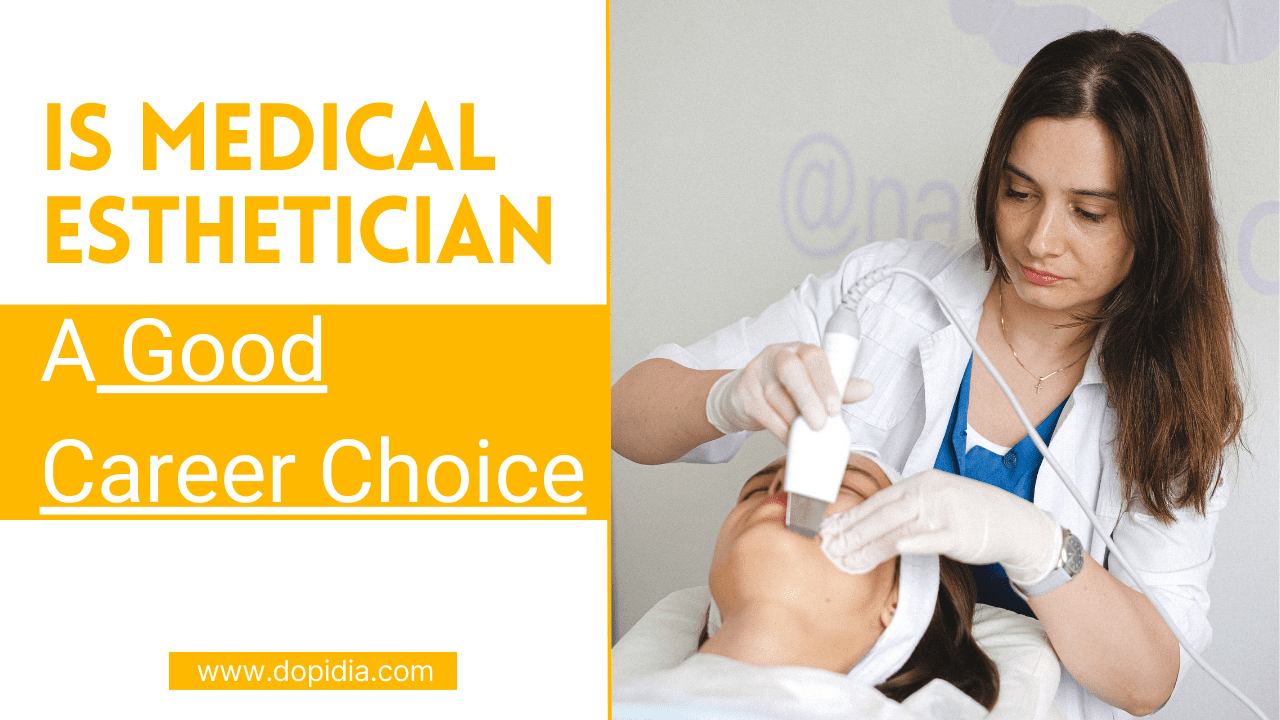Is Medical Esthetician a Good Career Choice
If you have a passion for skincare and helping others feel confident in their own skin, a career as a medical esthetician could be the perfect fit for you. In recent years, the demand for skincare treatments and services has been on the rise, making the field of medical esthetics a lucrative and rewarding career choice in the United States. In this article, we will explore the ins and outs of becoming a medical esthetician and why it could be a good career choice for you.
What is a Medical Esthetician?
A medical esthetician, also known as a paramedical esthetician, is a skincare specialist who has received additional training in advanced skincare treatments and procedures. Unlike traditional estheticians, medical estheticians are qualified to perform medical-grade treatments such as chemical peels, microdermabrasion, and laser therapy.
They often work in medical spas, dermatology clinics, or plastic surgery offices, collaborating with healthcare professionals to provide comprehensive skincare services to their clients. In addition to providing treatments, medical estheticians also educate their clients on skincare regimens and recommend products to improve and maintain healthy skin.
Job Outlook and Salary of a Medical Esthetician
The job outlook for medical estheticians remains positive, with steady growth projected in the skincare industry. According to the U.S. Bureau of Labor Statistics (BLS), employment of skincare specialists, including medical estheticians, is expected to increase by 9% from 2022-32, much faster than the average for all occupations.
This growth is attributed to the rising demand for skincare treatments as people increasingly seek non-invasive cosmetic procedures to address aging, improve skin health, and boost self-confidence. Additionally, the proliferation of medical spas and wellness centers further contributes to job opportunities for medical estheticians.
The salary of a medical esthetician can vary depending on several factors, including geographical location, experience, level of education, certifications, and type of employer. According to data from the BLS, as of May 2022, the median annual wage for skincare specialists, which includes medical estheticians, was $38,060 per year. However, top earners in the field, typically those with advanced certifications and years of experience, can earn significantly higher salaries. In metropolitan areas or regions with a high demand for skincare services, medical estheticians may command higher wages.
Additionally, those working in medical offices, such as dermatology clinics or plastic surgery practices, tend to earn higher salaries compared to those employed in spas or salons. Advanced procedures like laser treatments or chemical peels may also increase earning potential. Overall, experienced medical estheticians can earn anywhere from $40,000 to $100,000 or more annually, depending on various factors.
Factors Influencing Salary Variation
Several factors can influence the salary potential of medical estheticians, including:
- Location: Salaries may vary based on regional demand, cost of living, and market competitiveness. Urban areas and regions with a high concentration of affluent clientele may offer higher earning opportunities for estheticians.
- Experience and Expertise: Estheticians with advanced certifications, specialized training, and a proven track record of delivering exceptional results often command higher salaries. Continued education and professional development can enhance earning potential and open doors to lucrative career opportunities.
- Employer Type: The type of establishment where an esthetician works can impact salary levels. For example, medical spas, dermatology clinics, and luxury resorts tend to offer higher wages compared to entry-level positions in beauty salons or spas.
- Clientele and Client Retention: Building a loyal client base and fostering strong relationships with clients can lead to increased referrals, repeat business, and higher earnings through tips and commissions.
Training and Education
Becoming a medical esthetician involves a combination of formal education, hands-on training, and often licensure or certification, depending on the regulations in your area. Here’s a general outline of the typical steps:
High School Diploma or Equivalent: Most programs require a high school diploma or GED equivalent as a prerequisite.
Post-Secondary Education: Pursue formal education through a reputable esthetician program. Look for programs that are accredited by national accrediting bodies or recognized by the state board of cosmetology or esthetics. These programs can vary in length from a few months to two years, depending on the depth of the curriculum.
Core Curriculum: Your coursework will cover fundamental topics such as skincare theory, anatomy and physiology, chemistry, sanitation and hygiene, cosmetic chemistry, and various techniques for facials, hair removal, makeup application, and more.
Specialized Training in Medical Esthetics: After completing the core curriculum, you may choose to pursue additional training specifically in medical esthetics. This can include learning about advanced skincare treatments like chemical peels, microdermabrasion, laser therapy, and injectables (under the supervision of a licensed healthcare provider). Some esthetician programs offer specialized tracks or certifications in medical esthetics.
Related Topics:
Is Transportation A Good Career Path
Is Industrial Machinery/Components a Good Career Path
Is Metal Fabrication a Good Career Path
Is Miscellaneous a Good Career Path
Clinical Experience: Gain hands-on experience through internships, externships, or clinical rotations in medical settings such as dermatology clinics, plastic surgery offices, medical spas, or esthetician practices that offer medical esthetic services. This practical experience is crucial for developing skills and understanding how to work with clients in a medical context.
Licensure or Certification: Depending on your location, you may need to obtain licensure or certification to practice as a medical esthetician. Requirements vary by state or country, but typically involve passing a written exam and/or a practical skills assessment. Some states also require continuing education to maintain licensure.
Continuing Education: Stay current with advancements in the field by participating in continuing education courses, workshops, conferences, or advanced training programs. Medical esthetics is a rapidly evolving field, so ongoing learning is essential for maintaining competence and offering the latest treatments to clients.
Professional Development: Consider joining professional organizations for estheticians or medical estheticians, such as the Associated Skin Care Professionals (ASCP) or the International Association for Physicians in Aesthetic Medicine (IAPAM). These organizations provide resources, networking opportunities, and support for career development.
By following these steps, aspiring medical estheticians can build a solid foundation of knowledge, skills, and experience to succeed in this specialized field.
Job Satisfaction
Job satisfaction among medical estheticians can stem from various factors related to the nature of the work, the environment, and personal fulfillment. Here are some aspects that often contribute to job satisfaction in this field:
Helping Clients Achieve Their Goals
Medical estheticians have the opportunity to make a meaningful difference in clients’ lives by addressing their skincare concerns and helping them feel more confident in their appearance. Seeing clients’ satisfaction and improved self-esteem can be incredibly rewarding.
Continuous Learning and Growth
The field of medical esthetics is dynamic and constantly evolving with new technologies, treatments, and techniques. Many professionals find satisfaction in staying updated on the latest advancements through ongoing education and training, which allows them to expand their skill set and offer innovative solutions to clients.
Autonomy and Creativity
Medical estheticians often have some degree of autonomy in their work, allowing them to customize treatment plans based on individual client needs and preferences. This creative aspect of the job can be fulfilling and empowering.
Positive Work Environment
A supportive and collaborative work environment can significantly impact job satisfaction. Medical estheticians who work in clinics, medical spas, or dermatology practices where they feel valued, respected, and supported by colleagues and supervisors are more likely to enjoy their work.
Work-Life Balance
Achieving a balance between work and personal life is essential for overall job satisfaction. While the nature of the job may involve some irregular hours, such as evenings or weekends, finding a schedule that allows for downtime and self-care is important for long-term happiness and fulfillment.
Recognition and Appreciation
Feeling appreciated for their hard work and dedication can boost morale and job satisfaction among medical estheticians. Recognition from clients, colleagues, and supervisors for delivering excellent service and achieving positive outcomes can be motivating and fulfilling.
Career Advancement Opportunities
Opportunities for advancement, such as moving into supervisory roles, transitioning to teaching or training positions, or starting their own esthetician practice, can provide a sense of progression and fulfillment for medical estheticians seeking to grow in their careers.
Impact on Overall Well-being
Job satisfaction is also influenced by factors such as job security, compensation, benefits, and job stability. Medical estheticians who feel adequately compensated for their skills and expertise and have access to benefits like healthcare, retirement plans, and professional development opportunities are more likely to experience job satisfaction.
Overall, job satisfaction in medical esthetics often stems from a combination of factors related to the nature of the work, the work environment, opportunities for growth and development, and the impact on clients’ lives. Finding fulfillment in helping others look and feel their best while also enjoying a positive work-life balance can lead to a rewarding and satisfying career as a medical esthetician.
Conclusion
In conclusion, a career as a medical esthetician can be a fulfilling and financially rewarding choice for those passionate about skincare and beauty. With a promising job outlook, competitive salary, and the opportunity to make a positive impact on others, becoming a medical esthetician is worth considering for anyone interested in the field of esthetics. If you are dedicated to helping others look and feel their best, pursuing a career as a medical esthetician could be the perfect fit for you.


